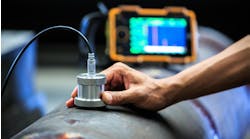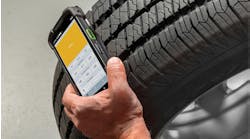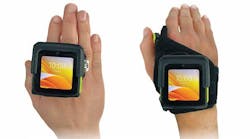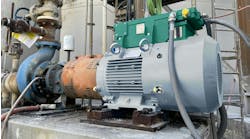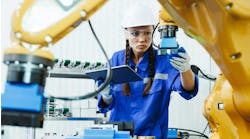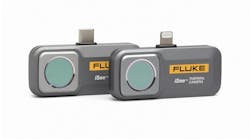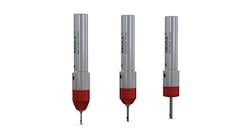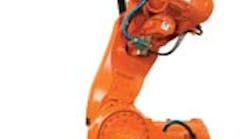Periods of weak demand are the ideal time to adopt robotic equipment for manufacturing, according to most robot designers. It allows the manufacturer to adjust its operation without impacting customer service, and it gives them access to the best engineers and resources when those assets are most available. One forging operation is in exactly this position. Southwest Steel Processing (SSP), a Park-Ohio subsidiary in Newport, AR, is having its production equipment reengineered in a project that will see four ABB Robotics forging-duty devices installed later this year.
In operation since 2003, SSP supplies its forgings in “raw,” machined, and heat treated condition, or as part of assemblies with other components.
The process equipment includes a 2,500-kW induction heater and a 6,000-ton mechanical forging press. SSP also operates shot-blasting systems, conventional and CNC machining centers, an induction-hardening system, hydraulic and mechanical finishing presses, GMAW/GTAW welding equipment, and CNC die sinking.
Currently, the plant operates with a “manpowered” forging process, using some mechanical devices to traffic and place heavy parts (some over 200 lb.) But, earlier this year SSP place an order with Girard Engineering for a collection of four ABB Robotics forging-duty units to speed and enhance the flow of material through the plant. Girard Engineering is an exclusive distributor and integrator of ABB robotic systems for forging.
These will be the first robotic devices in service for this forging operation. It will mean that SSP will be able to reassign its workers to less demanding or dangerous tasks than lifting and guiding hot, heavy billets through a “two-hit” forging process.
ABB designs a range of robotic devices for different industrial applications. The variations include lifting capabilities (up to 650 kg), range of motion (up to 3,500 mm, in six axes), and environmental shielding (insulated against heat up to 1,300°C, and sealed against flashes and particulate matter), with specially fabricated end-of-arm tools (EOAT.)
Better handling
The process update at SSP is underway now for completion later this year. The plan calls for one robot to pick up heated billets from the induction heater and transfer them to the main forging press operation. From there, a second robot will remove the part from the press and place it in position to transfer to the trim press.
While the billet is in the trim press, a third robot will handle the material during deformation. The idea is for the first robot to relieve the robot tending the main press from the task of picking/placing the billets from the induction heater. “In this way, the total throughput can be increased,” explains Girard engineering manager Michael O’Toole explains. “The robot that will unload the induction heater and load the first station of the press will be on a seventh axis, and that will allow us to eliminate any automation that may have been required to transfer the part from the heater to the main press robot.”
From that point, a third robot will remove the part from the trim press and place it on a conveyor.
O’Toole explains that the project assignment involves more than transferring the billets: “In addition to the material handling, we have been assigned the task of designing the safety cell around the work area, as well as integrating the robots with the press and heater controls.”
O’Toole confirms that the project is on schedule, with all the critical deadlines being met. He indicates that Girard Engineering will finish up its testing and demonstration work with the three robots by mid-September, at its facility in Cleveland. The turnkey installation should be underway in Arkansas in early November, to be followed by a four-to-six-week startup and installation phase.
“Girard is taking this project from beginning to end,” according to O’Toole. “We have been working closely with SSP to develop the process. In the end we will have conceived, designed, engineered, programmed, and installed the entire system.”
Project goals
Southwest Steel Processing has a series of goals for this project. It wants to ensure that its product quality is consistently high, which, because of the large size and weight of its billets and forgings can be difficult to maintain: consistency and repeatability are hard to sustain with very large materials.
A second goal is to improve the process ergonomics for the operators. O’Toole adds that the cycle time will be improved as well “by reducing the comparatively large transfer times that are currently part of the manned process.”
Girard Engineering is handling the project as a turnkey assignment: it will integrate the robots with the entire production line, as well as install the system. “We are also responsible for the design of the safety system,” the engineering manager explains. “We will supply an operator interface to tie all of the line components together (heater, press, trim press).
“Furthermore,” says O’Toole, “we will be offering different modes of operation, where the main press can still be run by a human and the two other robots will be operational.” This calls for specially placed light curtains and other safety devices, which are within the range of its past robotic system projects, he points out.
Once the equipment is installed, O’Toole anticipates that Girard will provide some training services and troubleshooting (via VPN link) to SSP. Once the operators and maintenance teams are fully capable with the new design and capabilities, he predicts that forging throughput and productivity will increase for SSP.
O’Toole says the project has changed significantly since the concept stage. “We added one robot to the material handling side of the job to increase throughput,” he details, “and we added one robotic spraying system for press lubrication and die cooling.” He calls the spraying system an exciting new offering for Girard Engineering, and one of the critical components of the SSP line. “Superior die lubrication is essential to robotic applications,” he says. “Any parts that stick in dies can cause stoppages or potential crashes when robots are handling the parts.”
There were some design hurdles, too. O’Toole reports that the engineers had to “design around” particularly difficult parts, but he indicates confidence about the resolution. “We feel that we identified the boundary conditions and the other parts will fall inside the envelope,” he explains.
Adapting the design to SSP’s family of part geometries and weights has been challenging, he says, but the experience has been valuable, and exciting for the engineering group.
Design concepts
Designing and installing robotic equipment is an engineering skill — as is specifying and placing forging process equipment. Girard Engineering has combined these capabilities into a niche of its own. It takes a particular approach to the payload demands in its projects, specifically “the center of gravity” of the end-of-arm tool.
Because the robot is expected to reach repeatedly into a press with hot parts, the design of the EOAT has to be long enough to avoid damage to the robot, in case of an accident.
For this reason, O’Toole explains further, “we must not only consider the weight of the part to be carried, but also the weight of the EOAT. The combination of these two items gives rise to a center of gravity for the total load. When the geometry of the specific moves of the robots and the cycle time are taken into account, the robot model including payload and reach can be arrived at,” he says.
Girard Engineering has been integrating robots since 2003, and feels confident about its ability to select the appropriate equipment for any range of applications, especially for forging. “We believe that our extensive knowledge of the forging industry is what makes us superior to any robot supplier outside of forging,” O’Toole observes. He lists heat, scale, and graphite being a few of the factors that have to be considered in the choice of systems. As an ABB partner it has the builder’s expertise available during the design process, and it uses 3D modeling to place robots within the cell. “In this way we can simulate the process and verify robot moves and reach,” he says.
Regardless of the versatility and capability of a robot, O’Toole says the overall effectiveness of an installation can be compromised by a poor cell design or an inappropriate tooling selection. He also emphasizes the importance of maintenance training, for keeping robots operating at optimal performance levels.
With four robots going into service at Southwest Steel Processing late this year, the proof of these insights will be on display.
